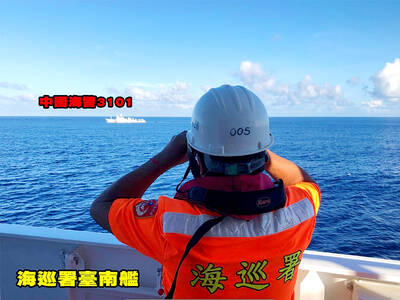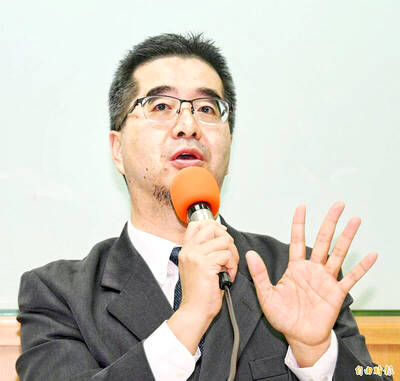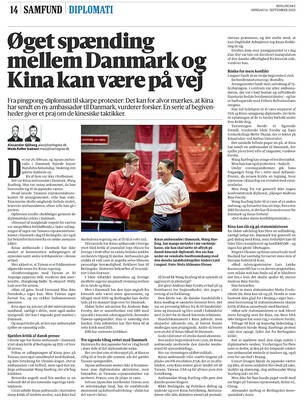Lin Chiu-an (林秋安) is a rising Taiwanese bonsai artist. He said that growing bonsai has became a popular art form throughout the world and that everyone could enrich their lives by owning bonsai trees and learning the basic knowledge required to take care of them.
Lin, who has a bonsai garden at Songheryuan Bonsai Park (松和園) in Wufeng (霧峰) District, Greater Taichung, has created a number of bonsai trees which have been displayed in bonsai exhibitions and entered into competitions around the nation.
“I do not think bonsai art is a Chinese-style or Asian-style art form … It is an art of the world because bonsai simulates trees in miniature and displays nature, which is to be loved and appreciated universally,” Lin said.
“To me the joy of cultivating bonsai trees is watching them develop and the way they change over the four seasons — buds open in spring, trees are lush and green in summer, leaves turn red and fall in autumn and the bare branches are beautiful in winter. Some species also grow fruits which I find most enjoyable,” he added.
The cultivation of bonsai requires patience, Lin said.
“Changes occur gradually. A normal tree will slowly change its shape year by year after periodic pruning. Slowly, the trunk and branches will grow into a beautiful tree,” Lin added. “This is why bonsai is called ‘living art.’”
Taiwan and Japan are the best in the world at bonsai art, but bonsai is becoming increasingly popular around the world. Bonsai associations and clubs are now booming in the Western world, Lin said.
Taiwanese bonsai cultivators have formed relationships with foreign bonsai lovers through international bonsai associations and we expect more communication and trading, Lin added.
People can enjoy owning their own bonsai trees with a basic knowledge of how to take care of plants — buying the trees, watering them properly, creating a good environment for photosynthesis to take place and preventing blight.
However, if people want to create bonsai artworks themselves, they must learn the basic skills and methods used, and the best way to do this is by attending bonsai classes, Lin added.
Lin has encouraged bonsai lovers go to the mountains to observe the shapes of different tree species in Taiwan.
“Juniper is grown at high altitudes. Affected by the violent geography and climate, it always develops a flexible trunk and branches. Their trunks are twisted and their leaves are shaped like needles. They are one of the most beautiful trees on the planet,” Lin said.
Along the road from Chingjing Farm to Hehuan Mountain (合歡山), Taiwan white fir and Taiwan red pine can be found, which display incredible shapes, Lin added.
The value of a bonsai tree depends on its age and how well it imitates nature. When choosing a tree it is important to avoid trees that look too artificial, Lin said.
Bonsai growers in Taiwan are lucky because of the temperate climate. The subtropical environment allows trees to grow faster and for longer, while the varied temperatures found in mountainous areas create a greater range of tree species.
Bonsai could become a creative cultural industry which could fuel Taiwan’s economy, Lin said.
The nation’s banyan and juniper bonsai are very popular around the world and are exported to Southeast Asia, China and the West because they suit most environments worldwide.
However, other bonsai species found in Taiwan, such as the jasmine orange which grows in Hengchun Peninsula (恆春半島), Pingtung County and the Taiwan white pine which grows along the valleys of the Dajia River (大甲溪) in Greater Taichung, would not suit climates outside of Taiwan, he added.

The Coast Guard Administration (CGA) yesterday said it had deployed patrol vessels to expel a China Coast Guard ship and a Chinese fishing boat near Pratas Island (Dongsha Island, 東沙群島) in the South China Sea. The China Coast Guard vessel was 28 nautical miles (52km) northeast of Pratas at 6:15am on Thursday, approaching the island’s restricted waters, which extend 24 nautical miles from its shoreline, the CGA’s Dongsha-Nansha Branch said in a statement. The Tainan, a 2,000-tonne cutter, was deployed by the CGA to shadow the Chinese ship, which left the area at 2:39pm on Friday, the statement said. At 6:31pm on Friday,

The Chinese People’s Liberation Army Navy’s (PLAN) third aircraft carrier, the Fujian, would pose a steep challenge to Taiwan’s ability to defend itself against a full-scale invasion, a defense expert said yesterday. Institute of National Defense and Security Research analyst Chieh Chung (揭仲) made the comment hours after the PLAN confirmed the carrier recently passed through the Taiwan Strait to conduct “scientific research tests and training missions” in the South China Sea. China has two carriers in operation — the Liaoning and the Shandong — with the Fujian undergoing sea trials. Although the PLAN needs time to train the Fujian’s air wing and

The American Institute in Taiwan (AIT) put Taiwan in danger, Ma Ying-jeou Foundation director Hsiao Hsu-tsen (蕭旭岑) said yesterday, hours after the de facto US embassy said that Beijing had misinterpreted World War II-era documents to isolate Taiwan. The AIT’s comments harmed the Republic of China’s (ROC) national interests and contradicted a part of the “six assurances” stipulating that the US would not change its official position on Taiwan’s sovereignty, Hsiao said. The “six assurances,” which were given by then-US president Ronald Reagan to Taiwan in 1982, say that Washington would not set a date for ending arm sales to Taiwan, consult

A Taiwanese academic yesterday said that Chinese Ambassador to Denmark Wang Xuefeng (王雪峰) disrespected Denmark and Japan when he earlier this year allegedly asked Japan’s embassy to make Taiwan’s representatives leave an event in Copenhagen. The Danish-language Berlingske on Sunday reported the incident in an article with the headline “The emperor’s birthday ended in drama in Copenhagen: More conflict may be on the way between Denmark and China.” It said that on Feb. 26, the Japanese embassy in Denmark held an event for Japanese Emperor Naruhito’s birthday, with about 200 guests in attendance, including representatives from Taiwan. After addressing the Japanese hosts, Wang